-
 Bitcoin
Bitcoin $84,965.9312
2.70% -
 Ethereum
Ethereum $1,904.0830
3.96% -
 Tether USDt
Tether USDt $0.9999
0.01% -
 XRP
XRP $2.1311
1.36% -
 BNB
BNB $608.0701
0.22% -
 Solana
Solana $125.9443
0.13% -
 USDC
USDC $1.0000
0.00% -
 Dogecoin
Dogecoin $0.1718
3.11% -
 Cardano
Cardano $0.6766
2.71% -
 TRON
TRON $0.2367
-1.21% -
 Toncoin
Toncoin $4.0378
-1.34% -
 Chainlink
Chainlink $14.0977
3.53% -
 UNUS SED LEO
UNUS SED LEO $9.3535
2.03% -
 Stellar
Stellar $0.2723
2.43% -
 Avalanche
Avalanche $19.4021
3.30% -
 Sui
Sui $2.4162
5.92% -
 Shiba Inu
Shiba Inu $0.0...01264
1.84% -
 Hedera
Hedera $0.1699
3.52% -
 Polkadot
Polkadot $4.1439
2.27% -
 Litecoin
Litecoin $84.2639
0.65% -
 MANTRA
MANTRA $6.3136
2.01% -
 Bitcoin Cash
Bitcoin Cash $309.1307
1.88% -
 Bitget Token
Bitget Token $4.6125
2.71% -
 Dai
Dai $1.0000
0.00% -
 Ethena USDe
Ethena USDe $0.9999
0.01% -
 Pi
Pi $0.7102
-3.65% -
 Hyperliquid
Hyperliquid $13.2450
0.65% -
 Monero
Monero $216.6375
0.58% -
 Uniswap
Uniswap $6.2829
4.07% -
 Aptos
Aptos $5.3579
1.34%
How does "Lightning Network" of blockchain increase transaction speed?
The Lightning Network enables near-instantaneous, low-cost transactions by processing them off-chain, significantly enhancing Bitcoin's speed and scalability.
Mar 31, 2025 at 11:21 am
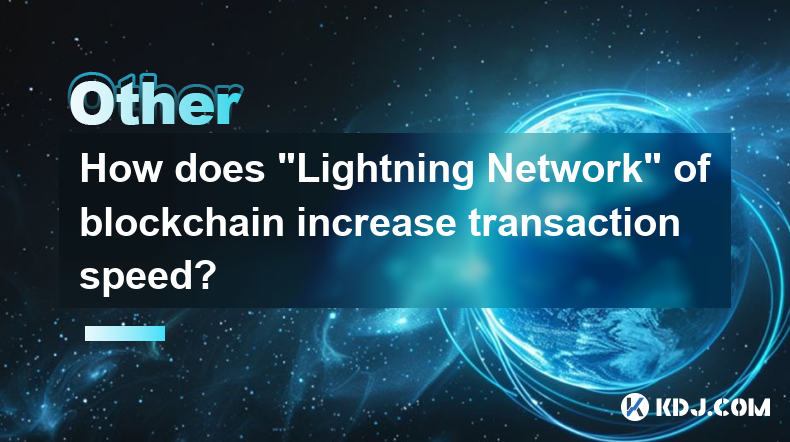
Understanding the Lightning Network's Speed Advantage
The Lightning Network (LN) is a layer-2 scaling solution built on top of Bitcoin and other cryptocurrencies. Its primary goal is to drastically increase transaction speed and reduce fees compared to on-chain transactions. Instead of broadcasting every transaction to the entire network, LN uses a network of payment channels between participants. This fundamentally alters how transactions are processed.
On-chain transactions require each transaction to be verified and added to the blockchain's public ledger. This process, while secure, is relatively slow and can become congested during periods of high activity. Transaction fees also increase as network congestion rises. The Lightning Network circumvents these bottlenecks.
How Lightning Network Works: A Step-by-Step Guide
The core of the Lightning Network's speed lies in its off-chain transaction mechanism. Here's a breakdown:
Channel Opening: Two parties wishing to transact open a payment channel. They collaboratively lock funds into a multi-signature escrow on the main blockchain. This initial on-chain transaction is the only one recorded on the main blockchain for the duration of the channel.
Off-Chain Transactions: Once the channel is open, transactions occur entirely off-chain. Participants exchange signed cryptographic messages to update the balance within the channel. These transactions are extremely fast and inexpensive.
Channel Closing: When the parties decide to close the channel, they broadcast a final transaction to the blockchain reflecting the current balance. This transaction updates the main blockchain, settling the final balance.
This off-chain transaction process is significantly faster than on-chain transactions because it avoids the need for constant blockchain verification. The speed increase is substantial, enabling near-instantaneous payments.
Security and Scalability of Lightning Network
The security of the Lightning Network relies heavily on the underlying blockchain's security. While transactions within the channels are off-chain, the channel opening and closing transactions are secured by the blockchain itself. This provides a strong foundation for trust and security.
Scalability is another key advantage. By moving transactions off-chain, the Lightning Network significantly reduces the load on the main blockchain. This allows for a much higher throughput of transactions without compromising the security or stability of the underlying blockchain. Many more transactions can be processed concurrently.
Addressing Potential Concerns and Limitations
One potential concern is the requirement for participants to maintain funds within the payment channels. This necessitates a degree of trust between participants, although the cryptographic mechanisms minimize the risk of fraud.
Another limitation is the complexity involved in setting up and managing payment channels. While user-friendly interfaces are emerging, the technical details can still present a barrier to entry for some users. However, ongoing development is focused on improving usability.
The Lightning Network isn't a replacement for the main blockchain; instead, it acts as a complementary layer, improving scalability and transaction speed. It's important to remember that the security of the system relies on the security of the underlying blockchain.
Frequently Asked Questions
Q: Is the Lightning Network only for Bitcoin?
A: While the Lightning Network was initially developed for Bitcoin, it's now being adapted for other cryptocurrencies. Several altcoins are exploring or implementing their own Lightning Network-like solutions. The core concepts are adaptable to various blockchain designs.
Q: How much faster are Lightning Network transactions?
A: The speed improvement is dramatic. On-chain Bitcoin transactions can take minutes or even hours to confirm, while Lightning Network transactions are typically confirmed within seconds, sometimes even milliseconds. The speed increase is several orders of magnitude.
Q: Are Lightning Network transactions free?
A: While significantly cheaper than on-chain transactions, Lightning Network transactions are not entirely free. There are still small fees associated with channel opening and closing, as these transactions occur on the main blockchain. However, these fees are generally much lower than the fees for on-chain transactions.
Q: Is the Lightning Network secure?
A: The security of the Lightning Network is based on the cryptographic security of the underlying blockchain. While transactions within channels are off-chain, channel openings and closings are secured by the blockchain. This dual-layered security provides a high level of protection against fraud and attacks.
Q: How can I use the Lightning Network?
A: You'll need a Lightning Network wallet. Several wallets now support the Lightning Network, offering user-friendly interfaces for managing channels and making payments. Research and choose a reputable wallet that meets your needs and security preferences. Always prioritize security when selecting a wallet.
Q: What are the limitations of the Lightning Network?
A: One limitation is the need to maintain funds within payment channels. Another is the potential complexity for new users in setting up and managing channels. However, ongoing development is addressing these issues with improved user interfaces and tools. Furthermore, the Lightning Network's scalability is still dependent on the underlying blockchain's capacity.
Q: What is the future of the Lightning Network?
A: The future of the Lightning Network looks promising. Ongoing development focuses on improving usability, expanding its capabilities, and broadening its adoption across various cryptocurrencies. It's expected to play an increasingly important role in scaling blockchain technologies and enabling faster, cheaper transactions. Its success will depend on continued development and user adoption.
Disclaimer:info@kdj.com
The information provided is not trading advice. kdj.com does not assume any responsibility for any investments made based on the information provided in this article. Cryptocurrencies are highly volatile and it is highly recommended that you invest with caution after thorough research!
If you believe that the content used on this website infringes your copyright, please contact us immediately (info@kdj.com) and we will delete it promptly.
- BlocScale, The first-ever decentralized IDO launchpad built on the XRP Ledger
- 2025-04-02 04:25:12
- Coinbase CEO Brian Armstrong wants U.S. laws to change so that stablecoin holders can earn interest
- 2025-04-02 04:25:12
- XRP Price Prediction: Crash or rebound?
- 2025-04-02 04:20:12
- The Bullish Catalysts and Risks of Investing in XRP
- 2025-04-02 04:20:12
- Tether purchased 8,888 Bitcoin in the first quarter of 2025 for approximately $735 million
- 2025-04-02 04:15:12
- DOGE May Undergo a 33% Correction, Targeting the $0.11-$0.12 Range
- 2025-04-02 04:15:12
Related knowledge
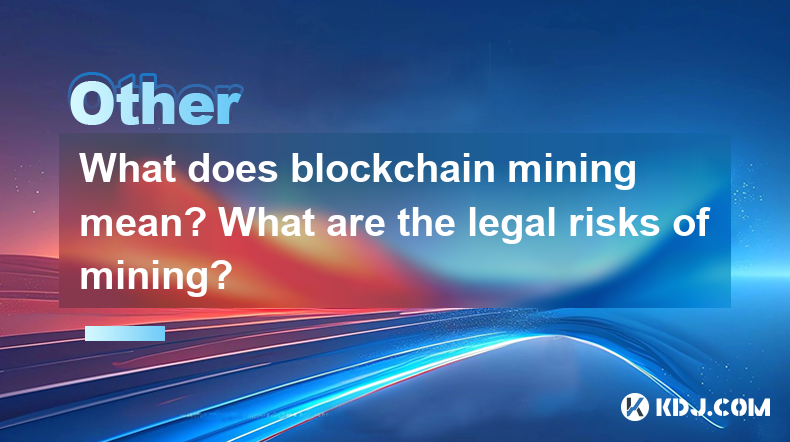
What does blockchain mining mean? What are the legal risks of mining?
Mar 31,2025 at 05:07pm
Blockchain mining is the process by which transactions are verified and added to the public ledger, known as the blockchain. Miners use powerful computers to solve complex mathematical problems, which, once solved, allow them to add a block of transactions to the blockchain. In return, miners are rewarded with cryptocurrency, typically Bitcoin. This pro...
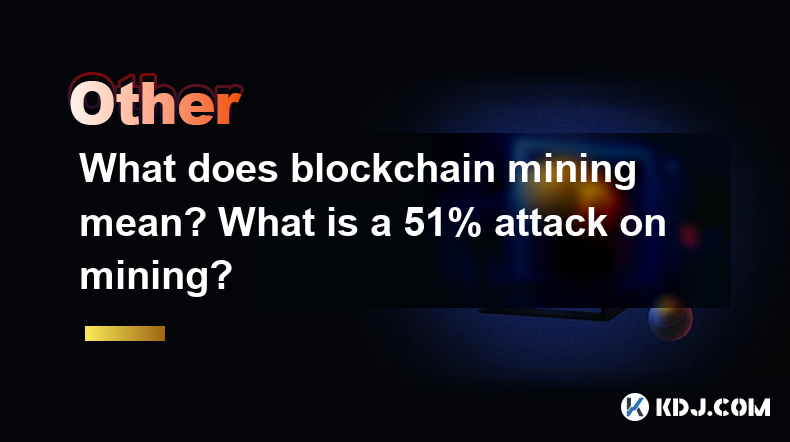
What does blockchain mining mean? What is a 51% attack on mining?
Apr 02,2025 at 03:28am
Blockchain mining is a critical process in the world of cryptocurrencies, particularly those that use proof-of-work (PoW) consensus mechanisms like Bitcoin. Mining involves using computational power to solve complex mathematical puzzles, which, when solved, validate and add new transactions to the blockchain. Miners are incentivized to participate throu...
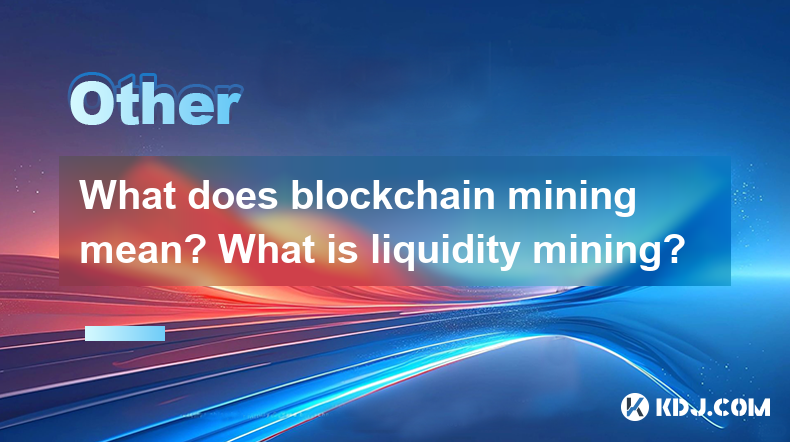
What does blockchain mining mean? What is liquidity mining?
Apr 01,2025 at 12:07am
What is Blockchain Mining?Blockchain mining is a critical process in the world of cryptocurrencies, particularly for networks like Bitcoin and Ethereum. It involves the use of computational power to solve complex mathematical problems, which in turn validates transactions and adds them to the blockchain. Miners are incentivized through rewards, typicall...
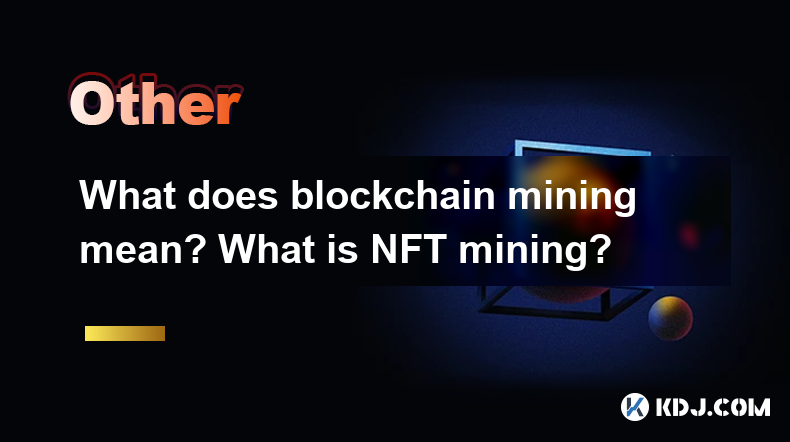
What does blockchain mining mean? What is NFT mining?
Mar 31,2025 at 04:07pm
Blockchain mining is a crucial process in the world of cryptocurrencies, particularly for networks like Bitcoin and Ethereum. It involves verifying transactions and adding them to the blockchain, a decentralized ledger. Miners use powerful computers to solve complex mathematical problems, which, when solved, allow them to add a block of transactions to ...

What does blockchain mining mean? What is the difference between cold wallets and hot wallets for mining?
Apr 01,2025 at 07:56am
Blockchain mining is a critical process in the world of cryptocurrencies. It involves verifying transactions and adding them to the blockchain, a decentralized ledger. Miners use powerful computers to solve complex mathematical problems, which, when solved, allow them to add a block of transactions to the blockchain. In return, miners are rewarded with ...
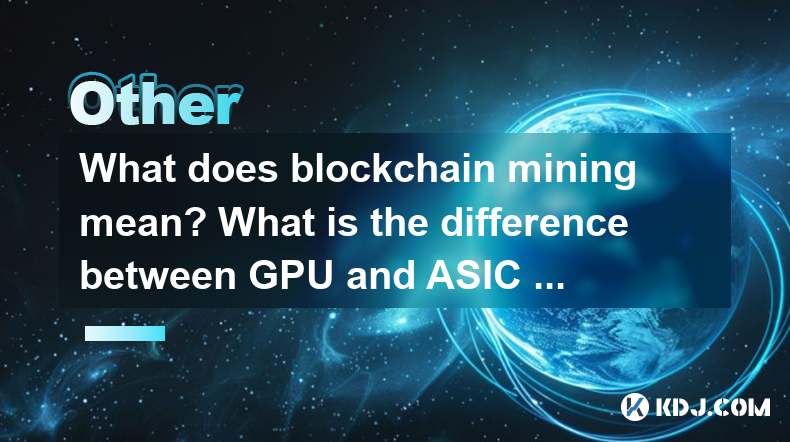
What does blockchain mining mean? What is the difference between GPU and ASIC mining?
Apr 01,2025 at 11:56am
Blockchain mining is a crucial process in the world of cryptocurrencies, particularly for networks like Bitcoin and Ethereum. At its core, mining involves solving complex mathematical problems to validate transactions and add them to the blockchain, a decentralized ledger. Miners compete to solve these problems, and the first to succeed is rewarded with...

What does blockchain mining mean? What are the legal risks of mining?
Mar 31,2025 at 05:07pm
Blockchain mining is the process by which transactions are verified and added to the public ledger, known as the blockchain. Miners use powerful computers to solve complex mathematical problems, which, once solved, allow them to add a block of transactions to the blockchain. In return, miners are rewarded with cryptocurrency, typically Bitcoin. This pro...

What does blockchain mining mean? What is a 51% attack on mining?
Apr 02,2025 at 03:28am
Blockchain mining is a critical process in the world of cryptocurrencies, particularly those that use proof-of-work (PoW) consensus mechanisms like Bitcoin. Mining involves using computational power to solve complex mathematical puzzles, which, when solved, validate and add new transactions to the blockchain. Miners are incentivized to participate throu...

What does blockchain mining mean? What is liquidity mining?
Apr 01,2025 at 12:07am
What is Blockchain Mining?Blockchain mining is a critical process in the world of cryptocurrencies, particularly for networks like Bitcoin and Ethereum. It involves the use of computational power to solve complex mathematical problems, which in turn validates transactions and adds them to the blockchain. Miners are incentivized through rewards, typicall...

What does blockchain mining mean? What is NFT mining?
Mar 31,2025 at 04:07pm
Blockchain mining is a crucial process in the world of cryptocurrencies, particularly for networks like Bitcoin and Ethereum. It involves verifying transactions and adding them to the blockchain, a decentralized ledger. Miners use powerful computers to solve complex mathematical problems, which, when solved, allow them to add a block of transactions to ...

What does blockchain mining mean? What is the difference between cold wallets and hot wallets for mining?
Apr 01,2025 at 07:56am
Blockchain mining is a critical process in the world of cryptocurrencies. It involves verifying transactions and adding them to the blockchain, a decentralized ledger. Miners use powerful computers to solve complex mathematical problems, which, when solved, allow them to add a block of transactions to the blockchain. In return, miners are rewarded with ...

What does blockchain mining mean? What is the difference between GPU and ASIC mining?
Apr 01,2025 at 11:56am
Blockchain mining is a crucial process in the world of cryptocurrencies, particularly for networks like Bitcoin and Ethereum. At its core, mining involves solving complex mathematical problems to validate transactions and add them to the blockchain, a decentralized ledger. Miners compete to solve these problems, and the first to succeed is rewarded with...
See all articles























































































